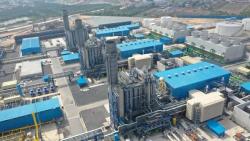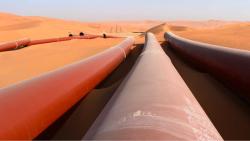
OR WAIT null SECS
© 2024 MJH Life Sciences™ and Turbomachinery Magazine. All rights reserved.
Using aeroderivatives in LNG production
The Darwin LNG Facility is the world’s first liquefaction facility to use aeroderivative gas turbines for its refrigeration compressors. The application of aeroderivative engines allows a significantly lower CO2 footprint of 20-30% compared to the use of simple cycle industrial (heavy duty) gas turbines. Below are excerpts from the paper "World's First Aeroderivative Based LNG Liquefaction Plant - Design, Operational Experience and Debottlenecking" by Cyrus Meher-Homji of Bechtel Corporation, David Messersmith of Bechtel, Hans Weyermann of ConocoPhillips, Gary Richardson of Darwin LNG, Paul Pattrick of Darwin LNG, Fernando Biagi of GE Oil and Gas, and Francesco Gravame of GE Oil and Gas.
The plant is a nominal 3.7 million tonne per annum (MTPA) capacity LNG plant at Wickham Point uses the ConocoPhillips Optimized Cascade® LNG Process1. It is located in
Darwin Harbor
,
Northern Territory
,
Australia
, and is connected via a 500-km, 26” subsea pipeline to the Bayu-Undan offshore facilities. The Bayu-Undan Field was discovered in 1995 approximately 500 kilometers northwest of
Darwin
,
Australia
in the
Timor Sea
. This field contains 3.4 TCF gas and 400 MMbbls of recoverable condensate and LPG.
The facility initially used six PGT25+ gas turbines with high-speed power turbines for the three refrigeration services, with two drivers for propane refrigeration, two drivers for ethylene refrigeration and two drivers for methane refrigeration. This engine uses the LM2500+ gas generator coupled to a high speed power turbine (HSPT). The facility is the first LNG plant to use media based evaporative cooling power augmentation for the six PGT25+ engines. The significant improvement in thermal efficiency compared to a traditional industrial gas turbine, results in a reduction of fuel consumption which reduces greenhouse gas in two ways.
First, there is a reduction in CO2 emissions due to a lower quantum of fuel burned. The second greenhouse gas benefit results from a reduction in the total feed gas required for the same LNG production. The feed gas coming
to the facility contains carbon dioxide, which is removed in an amine system prior to LNG liquefaction and is released to the atmosphere. The reduction in the feed gas (due to the lower fuel gas requirement) results in a reduction of carbon dioxide emissions from the unit.
The LNG plant incorporates several other design features to reduce greenhouse gas emissions. These include the use of waste heat recovery on the PGT25+ turbine exhaust. The waste heat is used for a variety of heating requirements within the plant. The facility also includes the installation of ship vapor recovery equipment. The addition of waste heat and ship vapor recovery equipment not only reduces emissions that would have been produced from fired equipment and flares, but also result in a reduction in plant fuel requirements. This reduction in fuel gas results in a lowering of carbon dioxide released to the atmosphere.
NOx control on the gas turbines is by means of water injection which maintains the flexibility to accommodate fuel gas compositions needed for various plant operating conditions.
The facility includes with a total of six refrigeration compressors configured as shown in Figure 3 in a 2+2+2 configuration (2 x propane compressor drivers, + 2 x ethylene compressor drivers and 2 x methane compressor drivers). Both the propane and ethylene trains had speed reduction gearboxes, with the methane being a direct drive. The power turbine is a high speed power turbine running at 6100 rpm.
Four of the gas turbines have once through steam generators located on their stacks to capture heat and produce steam which is used for process needs. All six gas turbines utilize pulse type filters and media type evaporative coolers fitted with drift eliminators.
The base engine was originally rated at 27.6 MW, and a nominal 37.5% ISO thermal efficiency. Since that time, its ratings have grown to its current level of 31.3 MW and a thermal efficiency of 41%.
The LM2500+ has a revised and upgraded compressor section with an added zero stage for increased air flow and pressure ratio by 23%, and revised materials and design in the high pressure and power turbines.
A critical factor in any LNG operation is the life cycle cost that is impacted in part by the maintenance cycle and engine availability. Aeroderivative engines have several features that facilitate “on condition” maintenance. Numerous
boroscope ports allow on-station, internal inspections to determine the condition of internal components, thereby increasing the interval between scheduled, periodic removal of engines. When the condition of the internal components of the affected module has deteriorated to such an extent that
continued operation is not practical, the maintenance program calls for exchange of that module. This allows “on condition maintenance”, rather than strict time based maintenance.
The engine is designed to allow for on-site, rapid exchange of major modules within the gas turbine. On-site component removal and replacement can be accomplished in less than 100 man hours. The complete gas generator unit can be replaced and be back on-line within 48 hours. The hot-section repair
interval for the aeroderivative is 25,000 hours on natural gas. However, water injection for NOx control shortens this interval to 16,000 hours to 20,000 hours depending on the amount of water injected, which in turn iss set by the NOx target level.
A general advantage of using aeroderivative engines for LNG service is that they can be uprated to newer variants, generally within the same space constraints. In 2010, the LNG facility instituted a debottlenecking project to upgrade all the gas turbines to the G4 variant. This uprated engine provides an increase in power of approximately 10%, by means of an increase in flow and a modest increase in control temperature.
Industrial gas turbines lose approximately 0.7% of their power for every 1
°
C rise in ambient temperature. This effect is more pronounced in aeroderivative gas turbines where the sensitivity can increase to well over 1% per °C. The gas turbines in
Darwin
use media type evaporative coolers.


